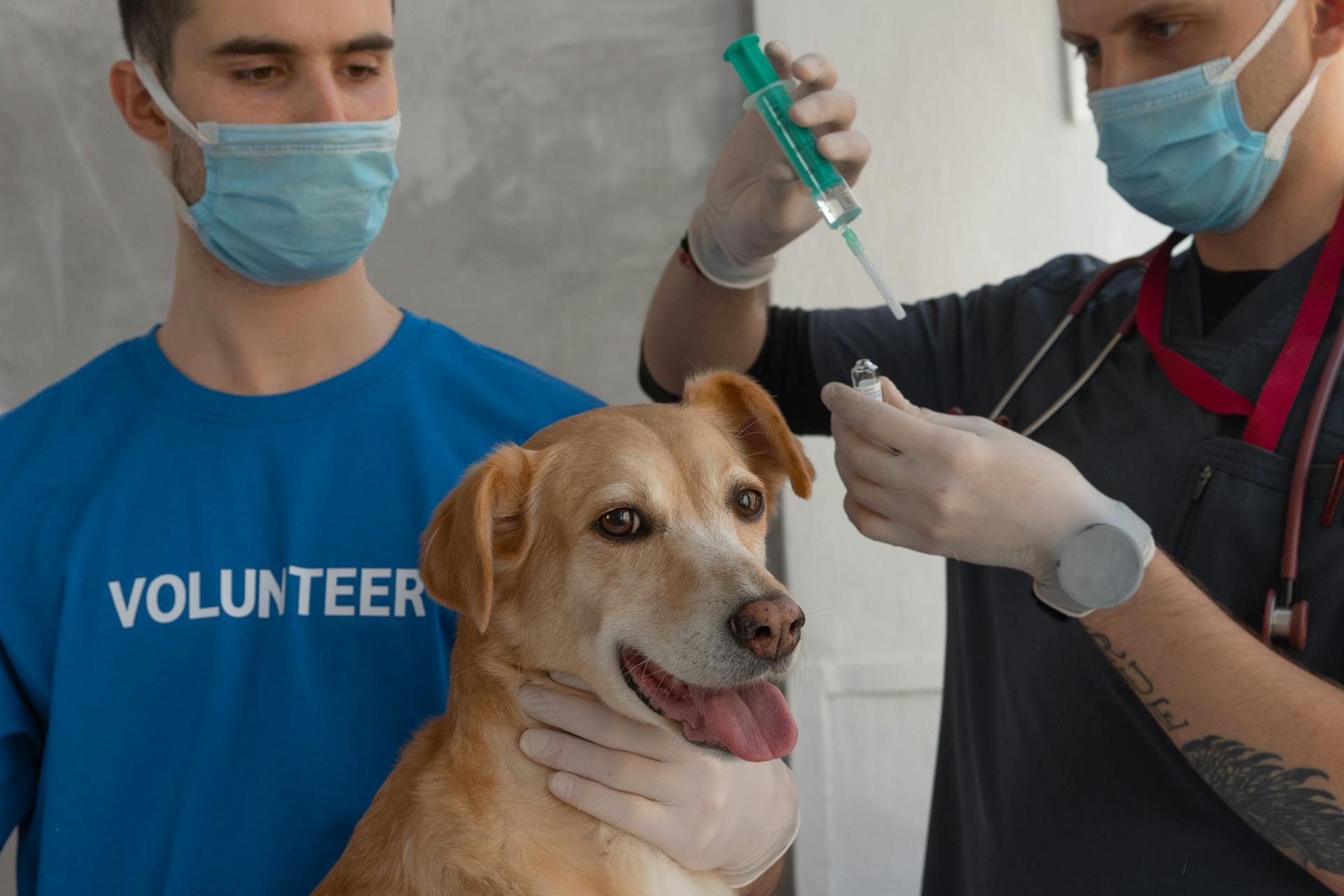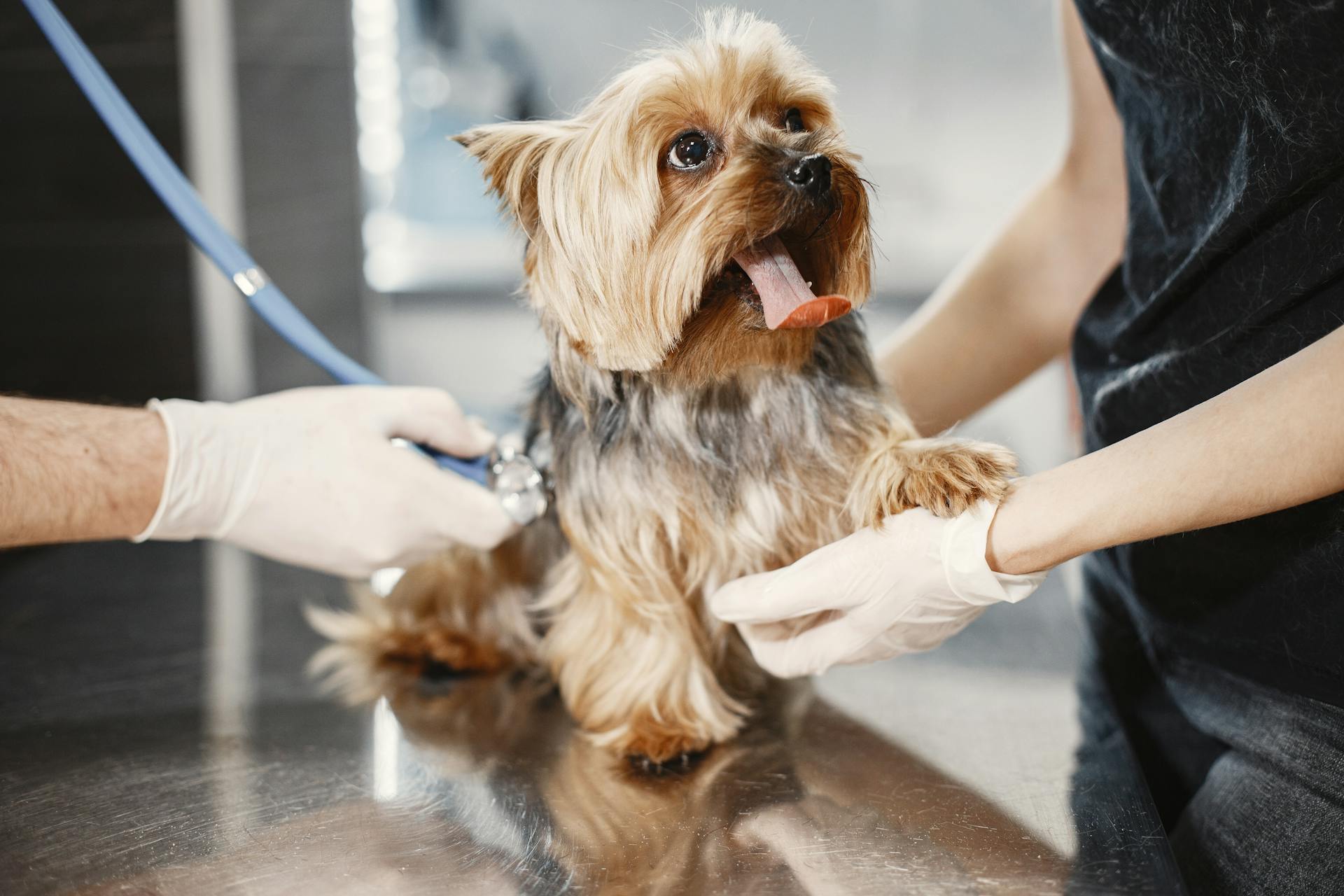
Dog flea treatment overdose symptoms can be alarming and even life-threatening. If you suspect your dog has overdosed on flea treatment, it's essential to act quickly.
Symptoms of a dog flea treatment overdose can include vomiting, diarrhea, and excessive salivation. In severe cases, your dog may experience tremors, seizures, or even collapse.
A dog's weight and sensitivity to the treatment can greatly impact the severity of symptoms. According to the article, a dog weighing less than 10 pounds is more susceptible to flea treatment overdose.
If you're unsure about the correct dosage or have any concerns, consult with your veterinarian for personalized advice. They can help you determine the best course of action for your dog's specific needs.
See what others are reading: Dog Calming Treats Overdose
Symptoms and Diagnosis
Symptoms of flea and tick medicine poisoning in dogs can be alarming and even life-threatening. They can develop within 15 minutes to several hours after ingestion or application to your dog's skin.
Scratching and intense itchiness are common symptoms, as well as restlessness and rolling around on the back or trying to bite the back. Your dog may also vocalize, cry, or whimper.
Redness, hair loss, and scarring can occur at the site of application, and drooling, vomiting, and lack of appetite are also possible. Gagging or hacking, agitation, muscle tremors, difficulty standing or walking, weakness, seizures, and even death can occur in severe cases.
If you suspect your dog is experiencing toxic side effects, call your veterinarian, ASPCA Poison Control, or the Pet Poison Helpline immediately for potentially life-saving treatment advice.
A presumptive diagnosis can be made by your veterinarian after a complete physical examination and a known or possible history of exposure to a product containing a pyrethrin or pyrethroid, or ingestion of flea/tick medicine.
The following symptoms may require emergency vet care:
- Seizures
- Difficulty standing or walking
- Weakness
- Death
In mild cases, adverse reactions such as excessive drooling, paw flicking/scratching, and ear twitching may be the only symptoms, and they often resolve on their own.
Causes and Prevention
Causes of flea and tick medicine poisoning in dogs can be unintentional, often resulting from the misuse of flea and tick prevention or accidental ingestion of insecticides.
Dogs can become poisoned through incorrect dosing, expired medications, or giving medications intended for cats. It's crucial to verify the correct drug, dose, and size of the product before medicating your dog.
Not all products may result in toxic symptoms, but it's essential to consult your veterinarian immediately if you notice any adverse effects.
Causes
Flea and tick medication poisoning in dogs is often caused by exposure to pyrethroids and/or organophosphates in flea and tick control products.
Mishandling or misuse of these products, such as incorrect dosing, can lead to toxic symptoms in dogs.
Ingestion of a topical product or using the wrong product at the wrong dose on the wrong schedule can also cause toxicity.
Pesticides must be used exactly as directed to minimize the chances for toxicosis.

Giving expired medications or cutting larger sizes into smaller pieces or giving multiple smaller doses can also lead to poisoning.
Don't give flea and tick medications labeled for cats to your dog, or vice versa, as this can be toxic.
Consult your veterinarian immediately if you notice any toxic symptoms.
Prevention
To prevent flea and tick medicine poisoning in dogs, it's crucial to follow all directions on flea and tick preventives and insecticides carefully. Ensure that your dog only receives his prescribed medication as flea and tick preventatives are dosed on body weight.
Don't give your dog more than one flea and tick medication at a time, as this can cause an accidental overdose and potentially interact with other medications. Always consult your veterinarian about the risk of drug interactions.
Using a vet-recommended flea and tick control product exactly as directed is key to prevention. This means storing medications out of reach when not in use to prevent accidental exposure between doses.
Notify your veterinarian about the presence of all animals and children in the home when choosing external parasite control.
Here's an interesting read: Can a Dog Get Fleas While on Flea Medication
Product Toxicity Prevention

Product toxicity prevention is crucial to ensure your furry friend's safety. Always verify the correct drug, dose, and size of the product before medicating your dog, and ensure that the proper time frame between doses has occurred.
Consult your veterinarian before applying or administering a flea control product to your pet for the first time. They'll give you the best recommendations for your pet and help you navigate the available options.
To prevent accidental exposure, follow all directions on flea and tick preventives and insecticides very carefully. Ensure that your dog only receives his prescribed medication as flea and tick preventatives are dosed on body weight.
Don't use part of a larger-sized dose or multiple smaller doses, as this may result in an overdose and increased chance of poisoning. When in doubt, bring your dog to the veterinarian for proper dose.
Store flea control products in a secure location away from children and pets. Don't use flea control products on or in young puppies, kittens, or on a pregnant or nursing pet without consulting your veterinarian and reading the label.
Related reading: Can I Use Dog Flea Shampoo on Cats
Here are some key dos and don'ts for flea control products:
- Use a veterinarian-prescribed or recommended flea control product.
- Read label directions carefully and follow them.
- If a topical product is applied, separate pets in a multi-pet household until the flea control product is dry so pets cannot lick topical products off each other.
- Store flea control products in a secure location away from children and pets.
Don't use more than one flea control product on your pet at a time unless prescribed by your veterinarian, and don't apply a flea control product for a dog to a cat.
Active and Inert Ingredients in Insecticides
Active and Inert Ingredients in Insecticides can be misleading. The term "active" ingredient, which targets and kills fleas, is scrutinized by the Environmental Protection Agency (EPA) through rigorous testing.
However, "inert" ingredients, which make up to 99.9% of a product, are not subject to the same level of scrutiny. They don't have to be listed on product inserts and packaging.
In fact, many "inert" ingredients are as toxic, or even more toxic, than the registered "active" ingredients. For example, naphthalene, a common "inert" ingredient, has been linked to cancer activity through inhalation.
The Federal Insecticide, Fungicide, and Rodenticide Act (FIFRA) of 1949 allows manufacturers to keep "inert" ingredients confidential, citing trade secrets as a reason.
Long-term studies on the effects of these pesticides are scarce, leaving us with a lack of understanding about the chronic effects of these chemicals.
See what others are reading: Dog Flea Medicine Side Effects
Treatment and Recovery
Prompt recognition and early treatment are crucial for a good prognosis. Your veterinarian might need to hospitalize your dog for supportive care, which can last several days.
Supportive care may consist of repeat bathing, intravenous fluids, anti-nausea medications, muscle relaxation, and seizure medication. Your veterinarian will also monitor your dog's temperature, blood sugar levels, and kidney function.
In some cases, emergency life-saving treatment to stop seizures or provide ventilatory support is required to stabilize the dog before decontamination. Decontamination involves removing the medication from the skin by bathing, and may also include induction of vomiting or administration of activated charcoal.
The prognosis is determined by the type of flea or tick product used, the amount and method of administration, the length of time since the product was administered or applied, and the health and age of the dog before the poisoning.
Here's an interesting read: Accidentally Gave Dog Double Dose of Flea Medication
Treatment of
Treatment of flea and tick medicine poisoning in dogs can be a serious matter, and it's essential to know what to expect. Depending on the severity of the toxicity and the symptoms your dog is displaying, treatment could be on an outpatient basis or require hospitalization for supportive care.

Hospitalization is often necessary when neurologic signs occur, which can require several days of care. Repeat bathing is a common part of supportive care, which can help remove the toxic substance from your dog's system.
Intravenous (IV) fluids are also used to help your dog stay hydrated and support their kidneys. Anti-nausea medications can help alleviate vomiting and other gastrointestinal symptoms.
Your veterinarian may also prescribe muscle relaxation and seizure medication to help manage symptoms. They will closely monitor your dog's temperature, blood sugar levels, and kidney function to ensure the best possible outcome.
Here are some common supportive care treatments for flea and tick medicine poisoning in dogs:
- Repeat bathing
- Intravenous (IV) fluids
- Anti-nausea medications
- Muscle relaxation
- Seizure medication
Steps to Recovery
Recovery from flea and tick medicine poisoning in dogs requires prompt recognition and treatment. If your dog is showing severe symptoms, get them to a vet immediately.
There is no specific antidote to the active ingredients in these products, so treatment focuses on managing symptoms and removing the medication from the dog's system. Decontamination, which involves removing the medication from the skin by bathing, is a crucial step in the recovery process.

In some cases, emergency life-saving treatment may be needed to stabilize the dog before decontamination can occur. This can include stopping seizures or providing ventilatory support. Induction of vomiting and administration of activated charcoal should only be performed by a veterinarian.
Mild cases may only require skin decontamination, while more serious cases may need a combination of decontamination and medication to relieve associated symptoms. These symptoms can include seizures, nausea, and muscle spasm.
Here are some common treatments used in more serious cases:
- Medications to relieve associated symptoms
- IV fluids
- Providing supplemental oxygen if the dog is having difficulty breathing
- Monitoring of vital signs, including temperature, blood sugar levels, and kidney function
The prognosis for recovery is determined by several factors, including the type of product used, the amount and method of administration, and the length of time since the product was administered or applied.
Sources
- https://www.petmd.com/dog/poisons/flea-and-tick-medicine-poisoning-in-dogs
- https://www.medvet.com/know-flea-product-toxicity-dogs-cats/
- https://www.whole-dog-journal.com/care/flea-care/are-topical-flea-killers-safe/
- https://vetster.com/en/conditions/dog/flea-tick-med-poisoning-dogs
- https://drjudymorgan.com/blogs/blog/side-effects-from-common-flea-and-tick-products
Featured Images: pexels.com


